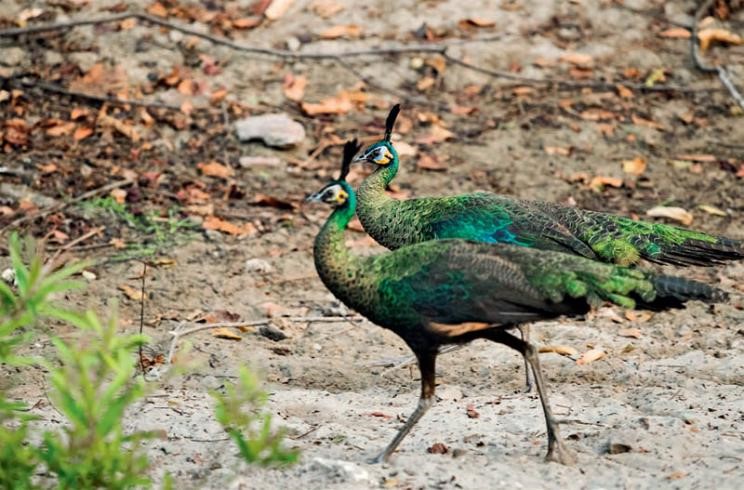Population of green peafowl sees steady recovery in China (2)
 |
| Green peafowl. (Photo/National Forestry and Grassland Administration of China) |
In recent years, China has significantly improved the habitats of green peafowl and made notable progress in protecting the species through measures including establishing and improving nature reserve system, launching special rescue projects, carrying out research and monitoring, and strengthening public awareness of green peafowl conservation.
Green peafowl, the only peafowl species native to China, is under first-class national protection in China. It is also one of the rarest and most endangered wild animal species.
The animal is only found in the central, western, and southern areas of southwest China’s Yunnan province. Their habitats are mainly highlands in basins of the Nujiang, Lancang, and Honghe rivers. It is categorized as species with extremely small population by China and Yunnan province.
Lately, infrared cameras installed at a green peafowl’s habitat located in the upper and middle reaches of the Honghe River captured scenes of six baby green peafowl foraging in forests.
This year, brooding has gone well in major home ranges of green peafowl in Yunnan, and some home ranges of the species have expanded, according to the forestry and grassland administration of the province.
In 2007, Yunnan formulated a plan for biodiversity conservation, specifying protection measures for species with extremely small populations. Two years later, the province issued a guideline and an emergency action plan targeting species with extremely small populations, which included green peafowl as one of the 20 key species for protection.
In 2018, the province included the habitats of 26 rare species, including green peafowl, into its ecological protection red line.
Yunnan also rolled out special implementation plans to step up efforts to protect green peafowl. As of last year, it had invested over 23 million yuan (about $3.57 million) in rescuing the species.
Green peafowl are found and protected as one of the key species in many of the nature reserves in Yunnan, including the Honghe National Nature Reserve, Yongde Snow Mountain Nature Reserve, Konglonghe Nature Reserve and Yubaiding Nature Reserve, said Xiang Ruwu, head of wildlife conservation division of the forestry and grassland administration of the province.
With natural resources effectively protected and ecological functions continuously enhanced, these nature reserves are offering a more hospitable living environment to green peafowl.
The provincial government of Yunnan has also set up an artificial breeding base for green peafowl and carried out relevant research together with research institutions, including the Kunming Institute of Zoology in the province, since 2019.
The 21 green peahens gathered by the government and research institutions have laid more than 100 eggs, with 27 chicks hatching out. A genomics-identified purebred population of green peafowl cultivated through artificial propagation has been initially established.
According to Xiang, the forestry and grassland administration, research institutes, non-profit organizations in Yunnan have explored many feasible approaches to green peafowl population monitoring, habitat management and protection, as well as rescue and protection-oriented manual intervention.
Through years of efforts, peafowl conservation areas in the province have all observed newborn baby peafowl. The annual number of peachicks procreated naturally has increased from 23 to 41.
The population of green peafowl has remained stable and risen in recent years, Xiang pointed out. Latest data from the forestry and grassland administration of Yunnan show its population stands around 555 to 600, which signifies the province’s progress in green peafowl habitat conservation as well as improvement in the population and distribution of the species.
At the Konglonghe Nature Reserve situated in Shuangbai county, Chuxiong Yi autonomous prefecture of Yunnan, green peafowl were only found in two areas of the reserve in 2015, when their population was less than 40.
In 2019, monitoring results indicated that green peafowl were found at all the suitable areas of the reserve, including some areas in the headwaters of the Lishejiang River where no green peafowl was found before. Besides, the population of the species at the reserve remained stable at above 100.
The population of green peafowl at the Yubaiding Nature Reserve and Honghe National Nature Reserve is also recovering steadily.
 |  |
Photos
 Bumper harvest presents a magnificent scene of terraced rice paddies in SW China's Luzhou city
Bumper harvest presents a magnificent scene of terraced rice paddies in SW China's Luzhou city In pics: life of Siberian tigers in NE China's breeding center
In pics: life of Siberian tigers in NE China's breeding center Explore wonderland created by an alpine lake cluster in SW China's Yunnan
Explore wonderland created by an alpine lake cluster in SW China's Yunnan In pics: Museums across China unveil creative and culturally-inspired mooncakes
In pics: Museums across China unveil creative and culturally-inspired mooncakes
Copyright © 2021 People's Daily Online. All Rights Reserved.






